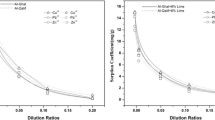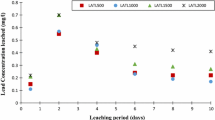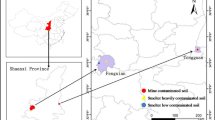Abstract
This article evaluates the desorption of heavy metals from lime-stabilized, contaminated semi-arid soils under harsh environmental conditions involving chemical extractants, specifically, acetic acid (CH3COOH), nitric acid (HNO3), ethylene diamine tetra-acetic acid (EDTA), and diethylene triamine penta-acetic acid (DTPA). In this study, heavy metals, such as arsenic (As), chromium (Cr), mercury (Hg), and lead (Pb), were spiked with two semi-arid soils (exhibiting different plasticity characteristics) at different load ratios (10–250 mg/kg); they were later stabilized with lime to evaluate the reduction in their mobility. Extensive desorption tests were performed on these soil mixtures to study the efficacy of lime for the in situ fixation of heavy metals. This study revealed that irrespective of the nature and size of the heavy metal, the removal efficiency for the soils was greater than 80%, and EDTA at a concentration of 1 M yielded the maximum removal efficiency. It was found that the cationic metal ions Hg and Pb were desorbed effectively by EDTA, while As was desorbed by HNO3 and Cr by DTPA. The order of desorption for heavy metals was found to be as follows: As > Cr > Hg > Pb. The lime amended soils exhibited lower removal efficiencies (more than 48% retained) due to efficient retention of metals in the soil interstices, making them inert and immobile. There was an improvement of 40% in soils amended with lime compared with virgin soils in the case where soil washing by harsh washing agents was resisted; this proves that the contaminants were embedded in the interstices of the soil calcium interfaces. Therefore, this study asserts the notion that the mobility of heavy metal ions from brownfields can be effectively reduced by in situ lime treatment.


Similar content being viewed by others
References
Peters RW (1999) Chelant extraction of heavy metals from contaminated soils. J Hazard Mater 66:151–210
Reddy KR, Chinthamreddy S (2000) Comparison of extractants for removing heavy metals from contaminated clayey soils. J Soil Sediment Contam 9:449–461
Dermont G, Bergeron M, Mercier G, Lafleche MR (2008) Metal contaminated soils: remediation practices and treatment technologies. J Pract Period Hazard Toxic Radioact Waste Manag 12(3):188–209
Reddy KR, Danda S, Yükselen-Aksoy Y, Al-Hamdan AZ (2010) Sequestration of heavy metals in soils from two polluted industrial sites: implications on remediation. Land Contam Reclama J 18:13–23
Ghosh S, Mukherjee S, Al-Hamdan AZ, Reddy KR (2013) Efficacy of fine-grained soil as landfill liner material for containment of chrome tannery sludge. J Geotech Geol Eng 31:493–500
Igberase E, Osifo P, Ofomaja A (2014) The adsorption of copper (II) ions by polyaniline graft chitosan beads from aqueous solution: equilibrium, kinetic and desorption studies. J Environ Chem Eng 2:362–369
Jayakumar R, Rajasimman M, Karthikeyan C (2014) Sorption of hexavalent chromium from aqueous solution using marine green algae Halimeda gracilis: optimization, equilibrium, kinetic, thermodynamic and desorption studies. J Environ Chem Eng 2:1261–1274
Trazzi PA, Leahy JJ, Hayes MHB, Kwapinski W (2016) Adsorption and desorption of phosphate on biochars. J Environ Chem Eng 4:37–46
Moghal AAB, Reddy KR, Mohammed SAS, Al- Shamrani MA, Zahid WM (2016) Lime amended semi arid soils in retaining copper, lead and zinc from aqueous solutions. Water Air Soil Pollut 227:372
Moghal AAB, Reddy KR, Mohammed SAS, Shamrani MAA, Zahid WM (2017) Sorptive response of chromium and mercury form aqueous solutions using chemically modified soils. ASTM J Test Eval 45(1):104–119
Ghosh A, Saez AE, Ela W (2006) Effect of pH, competitive anions and NOM on the leaching of arsenic from solid residuals. Sci Total Environ 363:46–59
Li N, Li X, Wang C, Shi X, Liu J (2016) Desorption of Cd(II) from tourmaline 46. At acidic conditions: kinetics, equilibrium and thermodynamics. J Environ Chem Eng 4:30–36
Zhu Z, Li W (2013) Efficient adsorption and desorption of Pb2+ from aqueous solution. J Environ Chem Eng 1:838–843
Dermont G, Bergeron M, Mercier G, Lafleche RM (2008) Soil washing for metal removal: a review of physical/chemical technologies and field applications. J Hazard Mater 152:1–31
Moghal AAB, Al-Obaid AK, Al-Refeai TO, Al-Shamrani MA (2015) Compressibility and durability characteristics of lime treated expansive semiarid soils. J Test Eval 43:255–263
Mohammed SAS, Moghal AAB (2016) “Efficacy of nano calcium silicate (NCS) treatment on tropical soils in encapsulating heavy metal ions: leaching studies validation” Innov. Infrastruct Solut 1:21
Mohammed SAS, Sanaulla PF, Moghal AAB (2016) Sustainable use of locally available red earth and black cotton soils to retain Cd2 + and Ni2 + from aqueous solutions. Int J Civil Eng 14(7):491–505
. EPA. 1996. Method 3050B: Acid digestion of sediments, sludges and soils. Revision 2
ASTM D3987-12: standard practice for shake extraction of solid waste with water. ASTM International, West Conshohocken
Harter RD (1983) Effect of soil pH on adsorption of lead, copper, zinc, and nickel. Soil Sci Soc Am J 47:47–51
Reemtsma T, Mehrtens J (1997) Determination of polycyclic aromatic hydrocarbon (PAH) leaching from contaminated soil by a column test with on-line solid phase extraction. Chemosphere 35:2491–2501
Ho TC, Ghai AR, Guo F, Wang KS, Hopper JR (1998) Adsorption and desorption of mercury on sorbents at elevated temperatures. Combust Sci Technol 134:263–289
Stanforth R, Qiu J (2001) Effect of phosphate treatment on the solubility of lead in contaminated soil. Environ Geol 41:1–10
Lenoble V, Bouras O, Deluchat V, Serpaud B, Bollinger JC (2002) Arsenic adsorption onto pillared clays and iron oxides. J Colloid Interface Sci 255:52–58
Tokunaga S, Hakuta T (2002) Acid washing and stabilization of an artificial arsenic-contaminated soil. Chemosphere 46:31–38
Cao X, Ma LQ, Rhue DR, Appel CS (2004) Mechanisms of lead, copper, and zinc retention by phosphate rock. Environ Pollut 131:435–444
Enell A, Reichenberg F, Warfvinge P, Ewald G (2004) A column method for determination of leaching of polycyclic aromatic hydrocarbons from aged contaminated soil. Chemosphere 54:707–715
Kleiv RA, Thornhill M (2004) Adsorptive retention of copper from acidic mine water at the disused sulphide mine at Løkken, central Norway—initial experiments using olivine. Miner Eng 17:195–203
Ladeira ACQ, Ciminelli VST (2004) Adsorption and desorption of arsenic on an oxisol and its constituents. Water Res 38:2087–2094
Lenoble V, Laclautre C, Serpaud B, Deluchat V, Bollinger JC (2004) As(V) retention and As(III) simultaneous oxidation and removal on a MnO2-loaded polystyrene resin. Sci Total Environ 326:197–207
Maturi K, Reddy KR (2008) Extractants for the removal of mixed contaminants from soils. J Soil Sediment Contam 17:586–608
Bhatnagar A, Vilar VJP, Botelho CMS, Boaventura RAR (2011) A review of the use of red mud as adsorbent for the removal of toxic pollutants from water and wastewater. J Environ Technol 32(3):231–249
Mishra SP (2014) Adsorption and desorption of heavy metal ions. J Curr Sci 104(4):601–612
Gates WP, Bordallo HN, Aldridge LP, Seydel T, Jacobsen H, Marry V, Churchman GJ (2012) Neutron time-of-flight quantification of water desorption isotherms of montmorillonite. J Phys Chem 116:5558–5570
Gonzalez CJ, Costaj J, Matias JM, Covelo EF (2017) Soil Cd, Cr, Cu, Ni, Pb and Zn sorption and retention models using SVM: variable selection and competitive model. J Sci Total Environ 593–594:508–522
Karna RR, Luxton T, Bronstein KE, Redmon JH, Scheckel KG (2017) State of the science review: potential for beneficial use of waste by-products for in situ remediation of metal-contaminated soil and sediment. J Crit Rev Environ Sci Technol 47(2):65–129
Goldberg S, Crisenti LJ, Turner DR, Davis JA, Cantrell KA (2007) Adsorption–desorption processes in subsurface reactive transport modelling. J Vadose Zone 6(3):407–435
Blais JF, Djedidi Z, Bencheikh R, Tyagi RD, Mercier G (2008) Metals precipitation from effluents: review. J Pract Period Hazard Toxic Radioact waste Manag 12:135–149
Potysz A, Grybos M, Kierczak J, Guiband G, Fondaneche P, Lens PNL, Van Hullebusch ED (2017) Metal mobilization from metallurgical wastes by soil organic acids. J Chemosphere 178:197–211
Santos NM, Nascimento CWA, Accioly AM (2017) Guideline values and metal contamination in soils of an environmentally impacted bay. J Water Air Soil Pollution 228(88):1–12
Lu N, Zhang C (2019) Soil sorptive potential: concept, theory and verification. J Geotech Geoenviron Eng 145(4):04019006
Bergendahl J (2005) Batch leaching tests: colloid release and PAH leachability. soil and sediment contamination. Int J 14:527–543
Jing C, Liu S, Patel M, Meng X (2005) Arsenic leachability in water treatment adsorbents. Environ Sci Technol 39:5481–5487
Larous S, Meniai AH, Lehocine MB (2005) Experimental study of the removal of copper from aqueous solutions by adsorption using sawdust. Desalination 185:483–490
Luo Z, Hu C, Zhou J, Cen K (2006) Stability of mercury on three activated carbon sorbents. Fuel Process Technol 87:679–685
Covelo EF, Vega FA, Andrade ML (2007) Heavy metal sorption and desorption capacity of soils containing endogenous contaminants. J Hazard Mater 143:419–430
Jegadeesan G, Al-Abed SR, Pinto P (2008) Influence of trace metal distribution on its leachability from coal fly ash. Fuel 87:1887–1893
Buchireddy PR, Bricka RM, Gent DB (2009) Electro kinetic remediation of wood preservative contaminated soil containing copper, chromium, and arsenic. J Hazard Mater 162:490–497
Cerqueira B, Covelo EF, Andrade-Couce ML, Vega FA (2011) Retention and mobility of copper and lead in soils as influenced by soil horizon properties. Pedosphere. 21:603–614
Baranimotlagh M, Gholami M (2013) Time-dependent zinc desorption in some calcareous soils of Iran. Pedosphere 23:185–193
Yang G-X, Jiang H (2014) Amino modification of biochar for enhanced adsorption of copper ions from synthetic wastewater. Water Res 48:396–405
Acknowledgements
The authors extend their appreciation to the Deanship of Scientific Research at King Saud University for funding this work through Research Group no. RG-1440-073. The authors thank the reviewers for their constructive comments which helped the cause of manuscript.
Author information
Authors and Affiliations
Corresponding author
Electronic supplementary material
Below is the link to the electronic supplementary material.
Rights and permissions
About this article
Cite this article
Moghal, A.A.B., Mohammed, S.A.S., Almajed, A. et al. Desorption of Heavy Metals from Lime-Stabilized Arid-Soils using Different Extractants. Int J Civ Eng 18, 449–461 (2020). https://doi.org/10.1007/s40999-019-00453-y
Received:
Revised:
Accepted:
Published:
Issue Date:
DOI: https://doi.org/10.1007/s40999-019-00453-y




